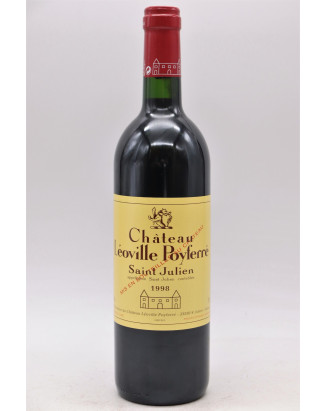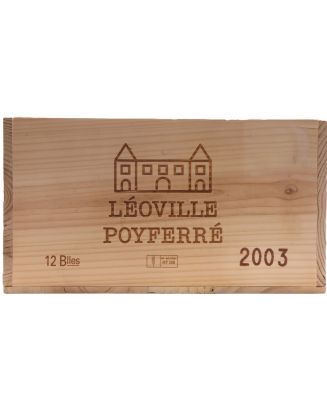










Château Léoville Poyferré originated from one of the largest wine estates in the Médoc, Léoville, founded in the 18th century. Initially called Mont-Moytié, it was renamed Léoville by Alexandre de Gascq, a visionary in the art of vineyard management. In 1840, a portion of this immense vineyard was passed on to the daughter of the Marquis de Las Cases, who married Baron Jean-Marie de Poyferré de Cérès. Thus, Château Léoville Poyferré officially took its name, becoming one of the three estates resulting from the division of the former Léoville, alongside Léoville Las Cases and Léoville Barton.
Despite the devastating epidemics of the late 19th century, such as phylloxera, the estate managed to survive thanks to the expertise of the Cuvelier family, who acquired it in 1920. With over a century of experience in wine trading, the Cuvelier family gradually modernised the vineyard, notably with the arrival of Didier Cuvelier in 1979, who initiated a vast programme of replanting and restructuring the facilities. Under his direction, the estate experienced a true revival, reinforced by the collaboration with renowned oenologist Michel Rolland from 1994.
In 2018, Sara Lecompte Cuvelier, Didier Cuvelier's niece, took over the estate, ambitiously pursuing the environmental commitment and viticultural excellence that have made Château Léoville Poyferré renowned.
The 2009 vintage of Château Léoville Poyferré received an excellent score of 98/100 from Robert Parker, while 2016, 2000, 1990 and 2018 scored 97/100, attesting to the richness and intensity of this great Saint-Julien.
The terroir of Saint-Julien is one of the most respected in the Médoc wine region. Located on the left bank of the Gironde, it benefits from a soil composed of deep gravel deposited by the river over centuries. These layers of gravel ensure optimal drainage and allow the vine roots to penetrate deeply, capturing essential nutrients to produce wines of exceptional complexity and richness.
The vineyard of Château Léoville Poyferré spans 80 hectares, distributed across different carefully selected plot clusters. Planted with 61% Cabernet Sauvignon, 27% Merlot, 8% Petit Verdot, and 4% Cabernet Franc, it reflects the full diversity and harmony of Bordeaux grape varieties. These proportions highlight the perfect balance between the power of Cabernet Sauvignon and the roundness of Merlot, enhanced by the spicy touches of Petit Verdot and the finesse of Cabernet Franc. The average age of the vines is 42 years, which allows for concentrated, high-quality grapes capable of ageing for many years.
For several years, the estate has been committed to a strict environmental approach, adopting the Environmental Management System for Bordeaux wines (SME) and obtaining level 3 High Environmental Value (HVE) certification from the 2017 vintage. This approach aims to preserve biodiversity and promote sustainable viticulture while respecting the unique terroir of Saint-Julien.
Vinification at Château Léoville Poyferré is based on a combination of technological innovation and respect for traditions. The harvest is carried out manually, ensuring precision and rigorous selection of grapes. Before entering the vats, the bunches are sorted twice: first by hand, then using sophisticated optical sorting, guaranteeing impeccable quality.
The estate has a modern vat room, equipped with 57 temperature-controlled stainless steel vats, including 27 double-walled vats, used for cold pre-fermentation macerations. This technique allows for preserving all the purity and aromatic intensity of the fruit while maintaining its brilliant colour. To protect the wine to the maximum, Château Léoville Poyferré has been using a bioprotection system based on non-Saccharomyces yeasts since 2018, which reduces the use of sulphur in the early stages of vinification.
The vinification process is then closely monitored by Isabelle Davin, the estate's oenologist, and Didier Thomann, cellar master, who carefully adjust the temperature, extraction duration, and oxygen supply to reveal the full potential of each cuvée. Malolactic fermentation takes place entirely in new French oak barrels, giving the wine a smoother texture and great stability.
The wine is aged for 18 months, entirely in French oak barrels, of which 75% are new. This long stay in wood allows the wine to develop complex aromas while remaining harmonious, with subtle and perfectly integrated oak notes. The final step before bottling involves traditional egg white fining, which refines the tannins to give the wine its silky and elegant structure.
Château Léoville Poyferré produces several cuvées that reflect the diversity and quality of its terroirs.
Château Léoville Poyferré
The flagship wine of the estate, it comes from the finest plots of the Saint-Julien appellation. Voluptuous, powerful, and fleshy, it offers a wide aromatic palette with notes of black fruits, spices, and precious woods. This wine has immense ageing potential, evolving towards more complex aromas over time. It is composed mainly of Cabernet Sauvignon, which gives it a remarkable structure.
Château Moulin Riche
Cultivated on a 20-hectare plot, this wine is distinguished by its freshness and generosity. More accessible than its elder Léoville Poyferré, Château Moulin Riche reflects the diversity of Saint-Julien terroirs. It is also marked by fruity and spicy notes, with supple tannins and a beautiful length on the palate.
Pavillon de Léoville Poyferré
This second wine of the Château is designed to offer a glimpse of the estate's excellence while being more accessible in its youth. Supple and delicate, Pavillon de Léoville Poyferré is distinguished by its roundness and melted tannins, perfect for earlier tasting.
Saint-Julien, a flagship appellation of the Médoc in Bordeaux, is renowned for its red wines of great finesse and longevity. Certain vintages particularly stand out for their exceptional quality, offering powerful, elegant and complex wines. Among the finest vintages, one finds years such as 1975, 1982, 1985, 1986, 1989 and 1990, which are true benchmarks for connoisseurs of age-worthy wines. More recent years have not been left behind, with notable vintages such as 1995, 1996, 2000, 2003, 2005, 2008, 2009, 2010, and 2012, all praised for their balance and ageing potential. The years 2014, 2015, 2016, 2017, 2018, 2019 and 2020 also distinguish themselves through their richness and complexity, continuing to make Saint-Julien an essential reference in the world of wine.
The Second Growths of 1855 constitute a prestigious category, grouping together iconic estates that often rival the First Growths in quality. Among them, discover Château Brane-Cantenac and Château Durfort-Vivens, both located in Margaux, as well as Château Lascombes, Château Rauzan-Ségla, and Château Rauzan-Gassies. In Saint-Julien, wine enthusiasts will appreciate the wines from Château Ducru-Beaucaillou, Château Léoville Las Cases, Château Gruaud Larose, and the famous Château Léoville Poyferré and Château Léoville Barton. Don't miss Château Cos d'Estournel and Château Montrose in Saint-Estèphe, as well as the essential Château Pichon Longueville Baron and Château Pichon Longueville Comtesse de Lalande in Pauillac.
Château Léoville Poyferré embodies the excellence of the Saint-Julien appellation, combining tradition, modernity, and respect for the environment. Thanks to the expertise of the Cuvelier family, its wines rank among the greatest growths of the Médoc, with a perfect balance between power and elegance. Whether through its main cuvées or its second wine, each bottle is the expression of a unique terroir and meticulous work from vine to cellar.